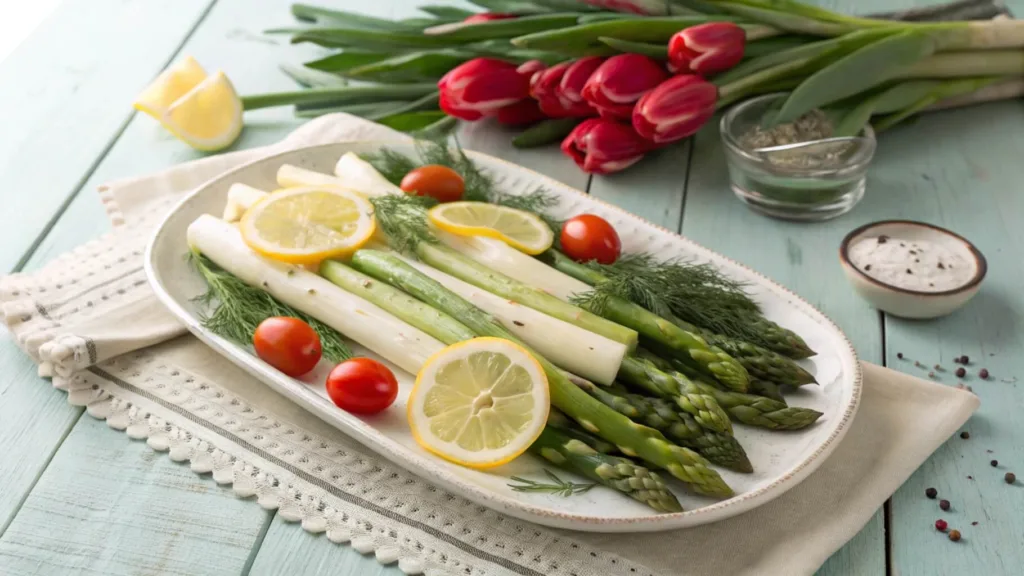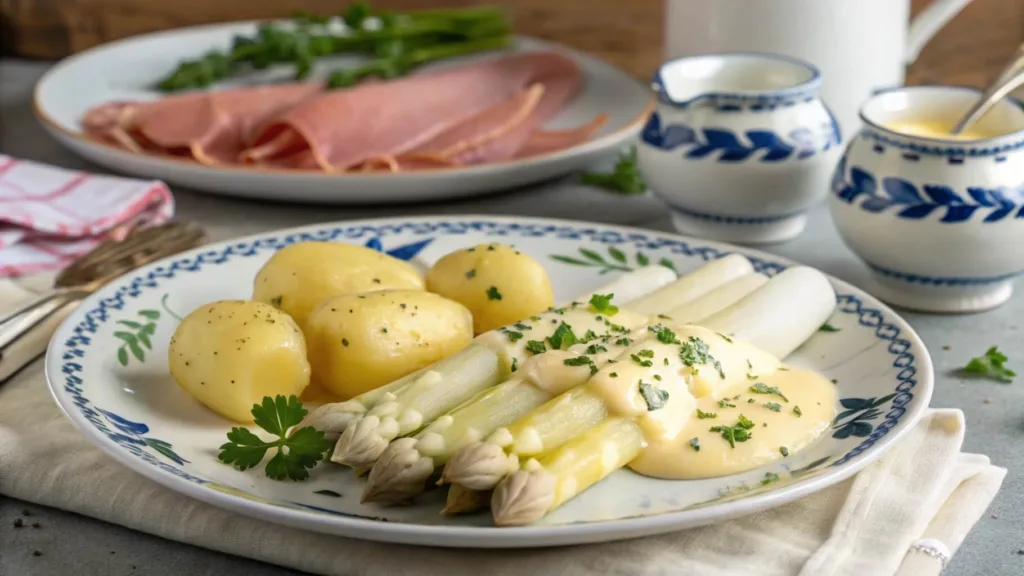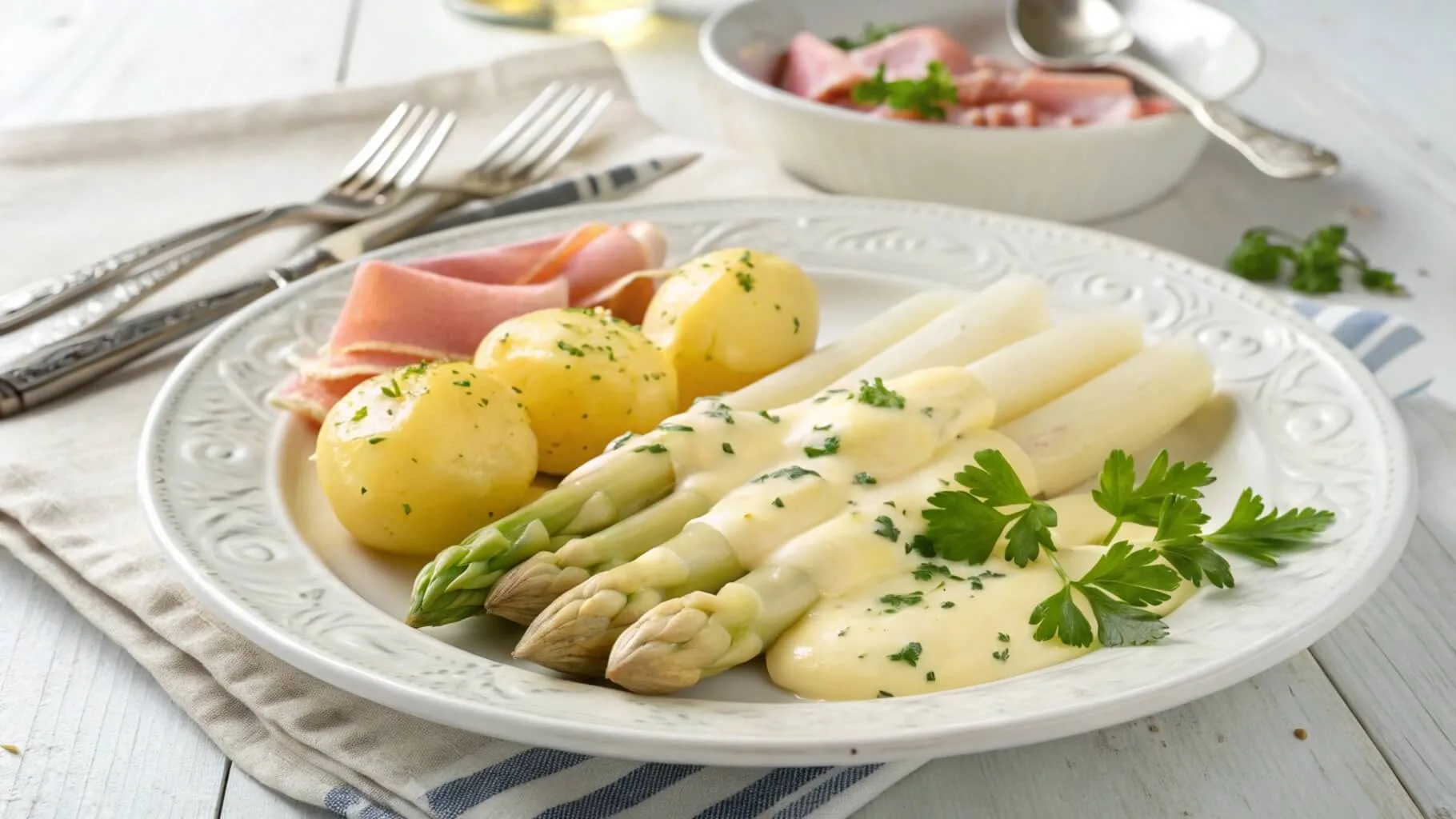Asparagus holds a special place in the heart of German cuisine. Known for its versatility and health benefits, this nutritious vegetable is celebrated in traditional and modern dishes alike. In this article, we’ll explore everything about asparagus German recipes, from its cultural significance to step-by-step cooking instructions. Let’s dive into the flavors of this beloved ingredient.
What Are Asparagus German Recipes?
Asparagus German recipes beautifully feature the creative use of asparagus in both traditional and modern dishes. In particular, these recipes often highlight the unique qualities of white asparagus (Spargel) and green asparagus, skillfully pairing them with complementary ingredients such as potatoes, ham, and rich sauces. Moreover, they range from hearty soups to elegant side dishes, showcasing a wide variety of preparation styles. Ultimately, these recipes not only capture the essence of German culinary traditions but also celebrate the versatility and timeless appeal of asparagus in the kitchen.
History and Cultural Significance
Asparagus has long been a staple in German cuisine, having been enjoyed for centuries. In fact, it first appeared in German cookbooks as early as the 16th century, and it quickly gained widespread popularity, particularly among the aristocracy. Over time, it evolved into more than just a culinary delight; today, it stands as a cherished symbol of spring. Furthermore, it is regarded as a seasonal treat that brings families and communities together through shared meals and traditions. Additionally, its cultural importance is highlighted annually during Spargelzeit, the asparagus season, when its harvest is celebrated with great enthusiasm across the country.
The Role of Asparagus in German Cuisine
In German cooking, asparagus is far more than just an ingredient—it is, in fact, a celebration of nature’s bounty and a reflection of the country’s appreciation for fresh, seasonal produce. Both white and green varieties are commonly used, and they contribute to dishes that skillfully emphasize the importance of incorporating local, high-quality ingredients. Furthermore, whether it is steamed to preserve its delicate flavor, grilled for a smoky twist, or incorporated into a rich and creamy soup, asparagus consistently adds a touch of sophistication to any meal. Ultimately, its versatility and elegance make it a cornerstone of German cuisine.
Why Germans Celebrate “Spargelzeit” (Asparagus Season)
“Spargelzeit” marks the height of spring, a time when white asparagus takes center stage in markets and kitchens. This celebration is deeply rooted in tradition, symbolizing renewal and abundance. During this season, families gather to enjoy classic asparagus German recipes, making it a cherished time of year. Aside from its cultural significance, asparagus is also celebrated for its numerous health benefits. Packed with vitamins and antioxidants, it’s a nutritious addition to any diet. Learn more about the health benefits of asparagus on healthline.com.
Types of Asparagus Used in German Recipes
White Asparagus: A German Favorite
White asparagus, also known as Spargel, is the crown jewel of German cuisine. Its mild flavor and tender texture make it perfect for steaming, roasting, or blending into soups. The cultivation process involves covering the stalks with soil to prevent photosynthesis, resulting in their unique pale color.
Green Asparagus in German Cooking
While not as traditional as its white counterpart, green asparagus is gaining popularity in German recipes. Its earthy flavor pairs well with lighter dishes like salads or grilled mains. Unlike white asparagus, it doesn’t require peeling, making it a convenient option.
Traditional German Asparagus Dishes
Asparagus with Hollandaise Sauce
This classic dish pairs steamed white asparagus with a rich, buttery hollandaise sauce. The combination of creamy sauce and tender asparagus creates a harmonious flavor profile that’s quintessentially German.
Asparagus Cream Soup
Known as Spargelsuppe, this soup is a comforting way to enjoy white asparagus. Made with pureed asparagus, cream, and a hint of nutmeg, it’s a velvety starter for any meal.
Spargel Salad
This light and refreshing salad effortlessly combines green asparagus with potatoes, eggs, and a tangy vinaigrette, creating a dish that is both flavorful and satisfying. Moreover, it’s an excellent option for a variety of occasions, whether you’re hosting a spring gathering, planning a picnic, or simply looking for a fresh and vibrant addition to your meal. Additionally, its balance of textures and flavors makes it a versatile choice that is sure to please a wide range of palates.
Modern Twists on Classic Recipes
Grilled Asparagus with Bavarian Flavors
Marinate green asparagus in olive oil, garlic, and Bavarian herbs before grilling to perfection. Serve it as a side dish with grilled sausages or schnitzel. For those who enjoy seafood pairings, try incorporating asparagus into a dish inspired by our fish food recipe for a creative twist.
Asparagus Risotto
This Italian-inspired dish incorporates white asparagus into a creamy risotto, blending the flavors of Germany and Italy into one delightful plate.
Asparagus Strudel
Wrap white asparagus in puff pastry with ham and cheese for a savory strudel that’s both elegant and delicious.
Seasonal Availability and Choosing the Best Asparagus
When Is Asparagus Season in Germany?
The asparagus season typically runs from late April to June. Known as the “queen of vegetables,” it’s harvested daily to ensure maximum freshness. While asparagus is a spring favorite, explore seasonal delights like our sweet potato recipe for Thanksgiving for fall-inspired meals.
Tips for Selecting Fresh Asparagus
- Look for firm stalks with closed tips.
- Check that the cut ends are moist and not dried out.
- Avoid stalks that appear woody or stringy.
Preparing Asparagus German Recipes for Cooking
Peeling and Cleaning White Asparagus
White asparagus, unlike its green counterpart, requires careful peeling to remove its tough outer layer, which is essential for achieving a tender texture. To begin, you should use a sharp vegetable peeler, starting just below the delicate tip and gradually working your way downward. Furthermore, it is important to trim the woody ends before cooking to ensure the stalks are completely edible. Additionally, taking these extra steps not only enhances the flavor but also ensures the asparagus is perfectly prepared for any dish.
Essential Kitchen Tools for Asparagus German Recipes
- Vegetable peeler: For peeling white asparagus.
- Asparagus steamer: Ensures even cooking.
- Sharp knife: For trimming and slicing.
Step-by-Step Recipes for Asparagus German Recipes
Recipe: Traditional Asparagus with Schnitzel
Ingredients:
- 1 lb white asparagus
- 2 breaded pork schnitzels
- 1 cup hollandaise sauce
- 1 lemon (sliced)
Instructions:
- Peel and trim the asparagus.
- Steam the asparagus until tender (about 10-12 minutes).
- Cook the schnitzels in a pan until golden brown.
- Serve the asparagus alongside the schnitzels, drizzling hollandaise sauce over the top. Garnish with lemon slices.
Recipe: Spargel Gratin
Ingredients:
- 1 lb white asparagus
- 1 cup grated Gruyere cheese
- 1 cup cream
- 2 tbsp breadcrumbs
- 1 tsp nutmeg
Instructions:
- Preheat the oven to 375°F (190°C).
- Peel and steam the asparagus until slightly tender.
- Arrange the asparagus in a baking dish.
- Pour cream over the asparagus and sprinkle with cheese, breadcrumbs, and nutmeg.
- Bake for 20-25 minutes until golden and bubbly.
Pairing Asparagus with German Beverages
Pairing asparagus with beverages is an art that elevates the dining experience. The delicate flavors of asparagus require drinks that complement without overpowering its taste. German beverages, such as sparkling water with a hint of lemon or herbal teas, are excellent companions. Their light and refreshing qualities enhance the natural flavors of asparagus.

To create an unforgettable pairing, consider the preparation style of your asparagus. Grilled asparagus pairs beautifully with a chilled, slightly citrus-infused sparkling water, while creamy asparagus soups work well with a mild chamomile or mint tea. Choosing the right beverage can transform an ordinary asparagus dish into a gourmet experience.
Best Beverage Pairings for Asparagus Dishes
When exploring non-alcoholic pairings for asparagus German recipes, certain options stand out for their ability to complement the vegetable’s unique profile:
- Citrus-Infused Sparkling Water: Perfect for dishes with citrus or herbal accents.
- Herbal Teas: Mild teas like chamomile or mint pair wonderfully with steamed or lightly seasoned asparagus.
- Creamy Milk Alternatives: Almond or oat milk works well with creamy or buttery sauces.
- Lightly Sweetened Lemonade: Adds a touch of sweetness to spiced asparagus dishes.
For celebrations, a chilled non-alcoholic sparkling beverage can provide a festive and effervescent touch while enhancing the meal.
Regional Beverage Recommendations
Germany’s regions offer diverse non-alcoholic options to complement asparagus German recipes:
- Rheingau: Known for its mineral-rich sparkling waters, perfect for roasted asparagus.
- Franconia (Franken): Offers herbal teas like chamomile, which highlight asparagus’s subtle sweetness.
- Mosel: Home to naturally flavored apple or pear ciders, ideal for pairing with asparagus soups.
- Pfalz: Produces refreshing fruit-infused sparkling waters that pair well with asparagus salads or quiches.
Regional non-alcoholic beverages not only elevate the meal but also celebrate local flavors in a wholesome way.nhance the flavors of asparagus but also provide a cultural connection to the dish.
Nutritional Benefits of Asparagus German Recipes
Asparagus is a nutrient-dense vegetable packed with essential vitamins and minerals. A single serving provides:
- Vitamin K: Supports bone health and blood clotting.
- Folate: Essential for DNA synthesis and cell repair.
- Vitamin C: Boosts immune function and skin health.
- Fiber: Aids digestion and promotes gut health.
Adding asparagus German recipes to your diet ensures a wholesome and flavorful way to meet your nutritional needs.
Health Advantages of Incorporating Asparagus
Regularly consuming asparagus can bring numerous health advantages. Its high antioxidant content fights free radicals, reducing inflammation and supporting overall well-being. Asparagus is also known to improve digestion due to its prebiotic fiber, which nourishes beneficial gut bacteria.
The low calorie content makes it a great choice for weight management. Moreover, asparagus is a natural diuretic, helping the body eliminate excess salt and toxins. By enjoying asparagus German recipes, you’re prioritizing both taste and health.
Asparagus German Recipes in a Balanced Diet
Incorporating asparagus into a balanced diet is effortless and rewarding. It pairs well with lean proteins like fish or chicken and complements whole grains such as quinoa or brown rice.
For a quick meal, try steamed asparagus with olive oil and a sprinkle of sea salt. Alternatively, roasted asparagus tossed in herbs adds a flavorful side to any main course. Asparagus German recipes often include cream-based sauces, which, when enjoyed in moderation, can fit into a well-rounded diet.
Regional Variations
Germany boasts diverse ways to prepare asparagus, reflecting the country’s regional culinary traditions.
Asparagus Dishes from Southern Germany
Southern Germany, particularly Bavaria and Baden-Württemberg, is renowned for hearty asparagus German recipes. Popular dishes include:

- Spargelsuppe: Creamy asparagus soup often garnished with croutons.
- Spargel mit Schinken: White asparagus wrapped in ham, served with hollandaise sauce.
- Asparagus Tart: A savory dish made with eggs, cream, and local cheeses.
The cuisine here focuses on rich flavors and indulgent textures, making it perfect for festive occasions.
Northern Germany’s Unique Asparagus Preparations
In Northern Germany, lighter preparations are favored. Common dishes include:
- Pickled Asparagus: Tangy and perfect as a snack or salad topping.
- Asparagus Salad: Often paired with mustard vinaigrette and fresh herbs.
- Grilled Asparagus: A smoky twist on traditional recipes.
These variations reflect the coastal influence, emphasizing fresh and vibrant flavors.
Tips for Hosting an Asparagus Feast
Hosting an asparagus-themed gathering, especially during Spargelzeit, requires thoughtful and careful planning to ensure success. Moreover, selecting fresh asparagus and crafting a menu that highlights its versatility are essential steps. Additionally, incorporating seasonal decor can enhance the festive atmosphere, making the event even more memorable.
Decor and Themes for “Spargelzeit” Gatherings
To set the mood, use decor inspired by springtime. Incorporate:
- Fresh flowers: Tulips or daffodils.
- Green and white linens: Reflecting the colors of asparagus.
- Rustic table settings: Highlighting German heritage.
This creates a welcoming and festive atmosphere for your guests.
Cooking for a Crowd
When preparing asparagus German recipes for a group, consider:
- Pre-trimming asparagus to save time.
- Choosing simple, scalable dishes like asparagus soup or salads.
- Offering a variety of wine pairings to cater to diverse tastes.
Preparation is key to ensuring your feast is memorable and stress-free.
Common Mistakes to Avoid When Cooking Asparagus German Recipes
Overcooking Asparagus
Overcooking is a common mistake that, unfortunately, leads to mushy and flavorless asparagus, diminishing its natural appeal. To avoid this, it is essential to use proper cooking techniques that retain its crisp texture and vibrant color. For example, you can blanch asparagus for no more than 3-5 minutes, which ensures it remains tender yet firm. Alternatively, roasting it until just tender is another excellent method that brings out its natural sweetness. Furthermore, by carefully monitoring the cooking time, you can preserve both the flavor and the visual appeal of this versatile vegetable.
Misjudging Flavors and Pairings
Pairing asparagus with overly bold flavors can overshadow its delicate taste. Avoid heavy red wines or overly spiced sauces. Stick to light, complementary ingredients to let asparagus shine.
FAQs
How do Germans eat white asparagus?
Germans typically enjoy white asparagus during the spring Spargelzeit (asparagus season), when it’s at its freshest. It’s often peeled to remove its fibrous outer layer and then steamed or boiled until tender. White asparagus is traditionally served with classic accompaniments such as hollandaise sauce, melted butter, boiled potatoes, and cured or smoked ham. Some variations include pairing it with schnitzel or incorporating it into soups and salads.
Why is Asparagus German Recipes so popular in Germany?
Asparagus, especially the white variety, is considered a seasonal delicacy in Germany, symbolizing the arrival of spring. Its mild and tender flavor makes it versatile for a variety of dishes. The cultural significance of Spargelzeit adds to its appeal, turning the asparagus harvest into a nationwide celebration with markets, festivals, and special menus. Additionally, its association with freshness and locally sourced produce resonates deeply with German culinary traditions.
What German city is famous for Asparagus German Recipes?
Schwetzingen, located in Baden-Württemberg, is renowned as the “Asparagus Capital of the World.” This historic city hosts annual asparagus festivals during Spargelzeit, attracting visitors with its rich agricultural heritage and dedication to white asparagus cultivation. Schwetzingen’s asparagus is celebrated for its exceptional quality and is often featured in traditional German recipes.
Why you shouldn’t snap the ends off asparagus?
Snapping the ends of asparagus, while convenient, can unfortunately result in unnecessary waste because the snapping point isn’t always precise. Instead, it is much more effective to trim the woody ends with a knife, as this method provides greater control. Moreover, it helps preserve the edible portions while only removing the tough, fibrous parts. Additionally, for white asparagus, peeling the stalk is absolutely essential to ensure a smooth and tender texture, making the dish even more enjoyable.
Conclusion
Recap of the Joy of Asparagus German Recipes
From its impressive nutritional benefits to its remarkable culinary versatility, asparagus is undeniably a true star in German cuisine. Furthermore, pairing it with local wines enhances its flavors, while exploring regional recipes allows you to appreciate its cultural significance. Whether you are hosting a festive feast or simply enjoying a quiet meal at home, asparagus German recipes consistently bring both joy and sophistication to the table.

